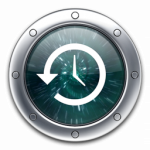
Imagine You use Apple OSX, imagine you like to play in Terminal, imagine you’re trying to fix some issue with a certain app in your ~/Library folder and you make a mistake, doing what’s not supposed to do:
rm -rf ~/Library/
This can cause big damage in your user account, even if it’s only for a few seconds, but it will probably be to late.1
This is just to introduce some tips and helps I’ve collected regarding Apple’s TimeMachine backup software.
Ok, lets start, first of all give thanks and link to all articles I’ve been looking at and saved in my del.icio.us are here.
Linux AFP server
If you have your own Linux serving AFP, edit your /etc/netatalk/AppleVolumes.default and add this options to your TimeMachine directory:
~/.TimeMachine "$u Backup" allow:YOUR_USERNAME cnidscheme:dbd options:usedots,upriv,tm
Enable Time Machine Network Volumes
If your network storage is not detected as a TimeMachine destination, type this in your terminal.
defaults write com.apple.systempreferences MShowUnsupportedNetworkVolumes 1
Starting new TimeMachine backup?
Mount your Network Shared Folder where you want time machine to be stored. In your localhost, open a terminal and create an image disk as follows:
hdiutil create -size 120g -fs HFS+J -volname "Backup of sheldon" sheldon_00111233a2da.sparsebundle
The image must be in format hostname_macaddress.sparsebundle; where 00111233a2da is the mac address from you computer default network adapter, used by TimeMachine as and ID. Find it through your terminal by typing
ifconfig en0 |grep ether | sed 's/\://g'
Copy the image in the shared folder as this way
rsync -avE sheldon_00111233a2da.sparsebundle /Volumes/TimeMachineNetworkBackupDestination/.
Disconnect from network volume and connect again, then you can go back to TimeMachine and configure your backup destination as your network volume should appear. If not, and you’re in Lion or MLion, you can use tmutil to configure from terminal.
sudo tmutil setdestination -p /Volumes/TimeMachineNetworkBackupDestination or
sudo tmutil setdestination afp://user:pass@host/share
Change TimeMachine backup time Intervals
Last number is the seconds you want between each backup (14400 = 4h).
sudo defaults write /System/Library/LaunchDaemons/com.apple.backupd-auto StartInterval -int 14400
Problems removing TimeMachine Backups
Trying to remove Backups.backupdb and you receive “operation not permitted” errors?
Use the following through command line for a quick and clean remove in Lion.
sudo /System/Library/Extensions/TMSafetyNet.kext/Contents/MacOS/bypass rm -rfv /Volumes/[disk]/Backups.backupdb/[path]
In Mountain Lion bypass has changed in place so you must type:
sudo /System/Library/Extensions/TMSafetyNet.kext/Helpers/bypass rm -rfv /Volumes/[disk]/Backups.backupdb/[path]
… And last one is
Fix Time Machine Sparsebundle NAS Based Backup Errors
Please follow this link for the whole process as I’m only describing the quicks.
Open terminal and become root
sudo su - Dive to directory where sparsebundle is stored and type this and wait:
chflags -R nouchg sheldon_00111233a2da.sparsebundle Once is done, type the next:
hdiutil attach -nomount -noverify -noautofsck sheldon_00111233a2da.sparsebundle
You will then see something like:
/dev/diskx Apple_partition_scheme
/dev/diskxs1 Apple_partition_map
/dev/diskxs2 Apple_HFSX
Check if fsck is working with:
tail -f /var/log/fsck_hfs.log Then, run ***fsck*** manually in the partition holding the data which should be *Apple_HFSX* or *Apple_HFS*.
fsck_hfs -drfy /dev/diskxs2
This will take a while and at the end, you’d either see:
`The Volume was repaired successfully´ or
`The Volume could not be repaired´
At the end, if all went well, just detach de sparsebundle
hdiutil detach /dev/diskxs2 … and give TimeMachine a new chance.
tmutil startbackup
-
Reminder: don’t touch things you shouldn’t touch. ↩